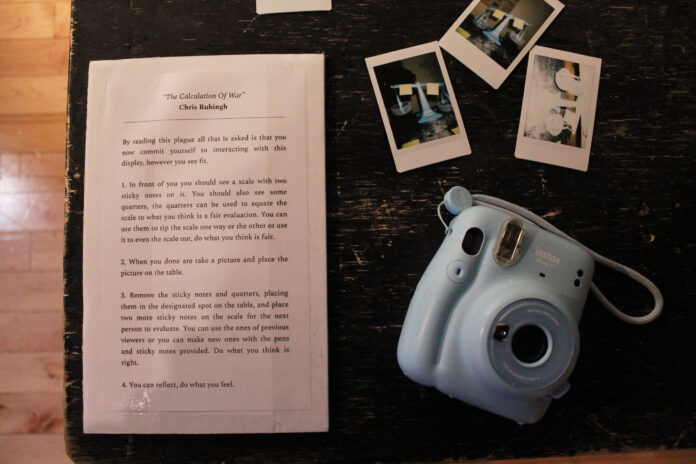
“The Hottest place in Hell is reserved for those who remain neutral in times of great moral conflict.” This quote along with the location of Trexler Pavilion, first-floor rehearsal hall, was sent around and circulated among the student body on the evening of Mar. 2. The message followed with another quote, “Art is not a mirror held up to reality but a hammer with which to shape it.” These two quotes conveyed to the student body one message– there was something happening on campus they should be aware of.
The message was meant to draw an audience to a student-curated art installation that took place in the Center for the Arts (CA) rehearsal hall. The installation contained a myriad of art forms created by a variety of student and alumni artists, that would evoke awareness for what is currently happening in Gaza and Palestinian territories. The installation was the idea of and curated by two students, Rachelle Montilus ‘24 and Chris Rubingh ‘24. They both expressed frustration and unease with the College’s handling (or lack thereof) of student responses to the inundate amounts of death occurring overseas and took it upon themselves to create a space where students can come together to relieve some frustration and bring awareness to an issue on the minds of the student body.
When discussing the idea behind the installation, and why it was significant to bring awareness through art, Rubingh stated, “Art can speak in a very visceral way which words alone cannot. We are in a place where art is taught, encouraged, celebrated— the theatre major is one of, if not the most popular majors here on campus,” Rubingh added, “I not only wanted to speak to the campus in a language it was familiar with but also make a statement about what we should be using our art and education for.”
Upon entering the exhibit, observers were met with multimedia forms of art. The walls were filled with frames of different forms of writing: poetry, letters and essays. Along with writing, the walls had visual pieces, including a piece by Emilio Ramírez ‘24 that was titled “Untitled,” and represented the lives of children under the age of one who have been killed by Israeli forces. The piece had the names of all the children written and was illegible, to show observers the scale of how many children have lost their lives.
The exhibit had more than written and visual pieces, there were interactive art pieces where observers were encouraged to fully immerse themselves in the art to gain a message, and audio and video pieces that triggered reactions from many. A piece that was near the middle of the exhibit was an audio and visual art form by Amira Jackson ‘24, titled “Alma.” This centers a 13-year-old girl named Alma and in her piece, Jackson incorporates a two-minute video where observers of the exhibit were able to hear Alma pleading for her family and her own life, as they are trapped under the rubble of a five-story building.
Jackson explained, “I remember when I first saw this video and I was numb. I couldn’t fathom how terrifying that must’ve been and how afraid she was, yet all she kept saying was ‘help my parents, my siblings and my grandparents. And I thought to myself, ‘No child or human should have to go through that.’”
The idea behind the installation was not only to call attention to the ongoing violence and the lives that are being lost and affected every day but to also serve as a call for action. Montilus reflected, “It’s all connected. Everything is connected, and we are directly responsible for changing that. I hope people get a larger sense of community for people who are in support of the Palestinian cause. I hope the Palestinian students who are here on campus feel supported.”
“We could have gone a lot of different routes, either done a performance or staged a piece. But [Rubingh] was uniquely interested in making something visual, that would give people the time to learn and contemplate, and then have things that were irrefutable in front of them,” Montilus continued.
The room of the first-floor rehearsal hall where the installation was set up was filled with art. If you were not actively looking at a visual piece, you were hearing an audio playing in the background. This was to overwhelm the senses of the audience, to fully capture their attention and evoke enough emotion in them for them to begin to care about a cause they might not have understood fully before the exhibit. Montilus crafted an audio piece titled “Zanana” that played in the background of the installation and heightened the emotions of the observers.
“It’s a soundscape of sounds I took from Palestinian journalist videos online, street noises of children coupled with audio of airstrikes in the background, a baby crying in the hospital and a doctor screaming after she realized the victim being brought into the hospital was her daughter,” Montilus added, “They’re all from real footage; ‘zanana’ is the term Palestinians use to describe the unmanned Israeli drones that fly overhead all during the days. ‘Zanana’ is a reference to the buzzing noise that played over the street noises the entire time.”
In giving insight into creating “Alma,” Jackson states, “This was my way of replicating the violence Alma experienced in a controlled setting that people have to engage with. They couldn’t turn the audio off or just swipe away, they had to stand and watch and listen to the cries of a 13-year-old Palestinian girl.”
The installation displayed different art forms by a variety of different students. All these students came together over a shared frustration and desperation to take some sort of action against the injustices being perpetrated against Palestinians. Each student came from a different background and had a unique grasp on what is occurring in Palestine, which was reflected in their art piece, and contributed to what made the installation so compelling.
Marissa Scharf ‘24 gave her reason for being a part of the exhibit, saying, “Over 30,000 Gazans have been killed— each an individual with a real life. With family, friends, hopes and dreams. We cannot let them become just numbers. And we must fight to save those who are still alive.”
“As a Jewish member of this campus community, I felt especially compelled to speak out against the horrific violence being done unto the Palestinian people,” Scharf added.
“If this violence is being carried out for the sake of ‘Jewish safety,’ I must have it be known that I reject the notion that this makes any of us safer. I reject the weaponization of Jewish trauma and grief. I reject this being done in my name and the name of my people. It has felt rather isolating at times to exist on this campus as a Jew who does not align with the prominent messaging of blind support and trust in Israel,” continued Scharf.
There was caution taken to ensure that the message of the installation would not be conflated with hatred or violence in any form. Montilus and Rubingh had crafted a mission statement for the exhibit where they clearly stated the objective of installation. They wrote, “To do this, we are looking to erect an art installation with the goal of illuminating the genocide in Palestine and the atrocities of the Palestinian/Israeli conflict and open up the campus community to a long overdue conversation. What we are NOT looking for: Incite violence/physical aggression on campus [or] platform anti-semitism.”
The exhibit was a one-day-only event, but it stayed with observers and artists alike in the following days. Maya Brooks ‘24 said, “The art installation completely blew me away. I was so impressed by how well executed it was and how it was able to stay quiet until it mattered. Shining a light on the atrocities happening to Palestinians was much needed, especially on our campus. It makes me feel good that something like this, created by students with a desire for change, was able to be so successful here.”
The exhibit was clear in its goal: to spark conversation and spread awareness of the Palestinian cause on campus. It was an outlet for many students to express their frustrations and feelings regarding the issue and the complacency of the College. It spoke heavily to many students, with people leaving the exhibit feeling a mix of grief, inspired and informed.
Lujane Alkhmos ‘27 reflected, “I hope that the student body was able to understand the severity of what is currently happening to the Palestinians and understand that their voice matters more than anything. Social media presence, attending protests and being loud about the ongoing genocide is crucial to helping put an end to the circumstances faced by the Palestinians.”
If there was one message you were meant to gain from the installation, it was that we as people hold more power than we believe. There is so much more action we can take to fight for what we believe to be right. In a time where people may feel overwhelming senses of hopelessness and powerlessness, this installation was a reminder that action can be taken in many forms. Rubingh reflected on this idea in the exhibit’s opening statement, “Do not be neutral, do not be silent. I can not do everything, but I can use my art, I can speak and I can take the action I can. Take the action you can. Form an opinion. Interact and take in the art you see today and use it. Agree with it. Disgrace with it. That is your call to action.”
Shinam ‘25 is a political science and sociology major at Muhlenberg. She is immensely excited to be apart of the Weekly staff! When she isn’t writing, she can be found reading a book or watching a comfort show with her favorite fast food!






















